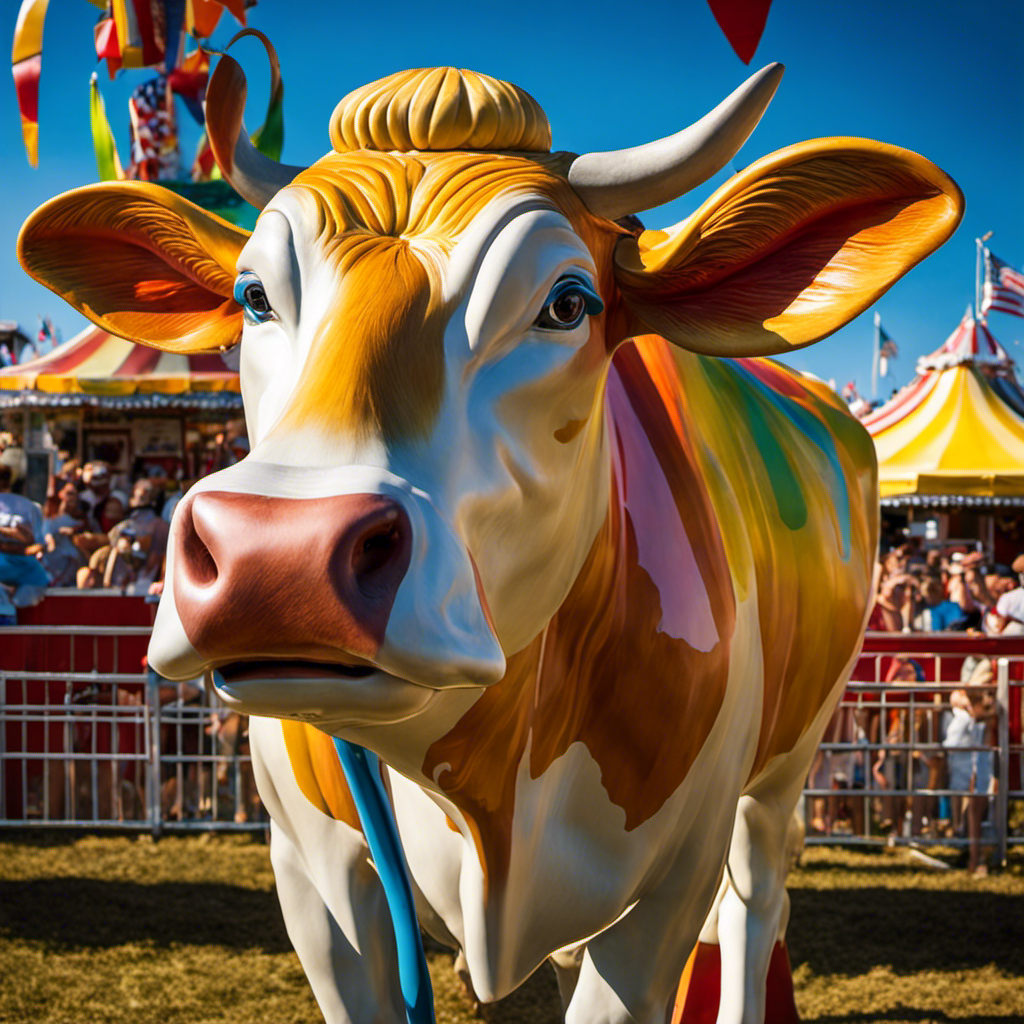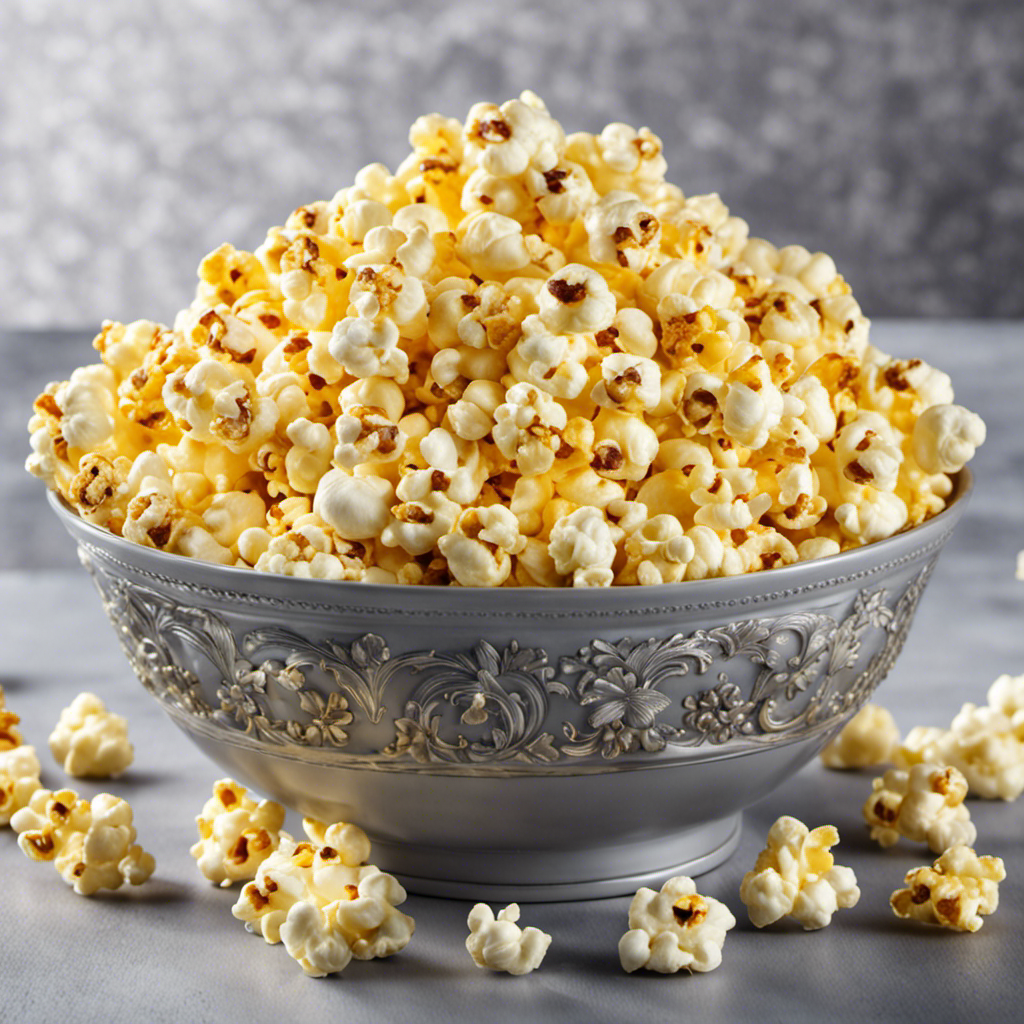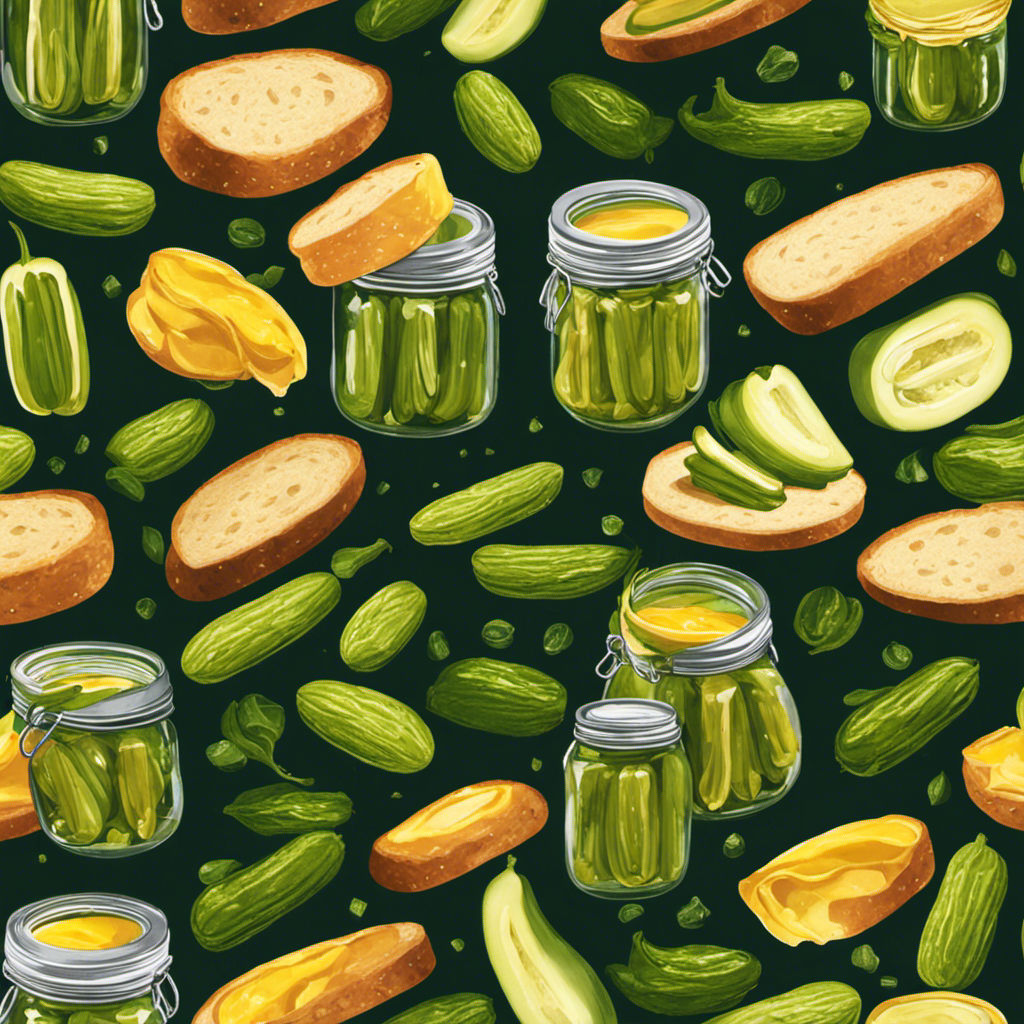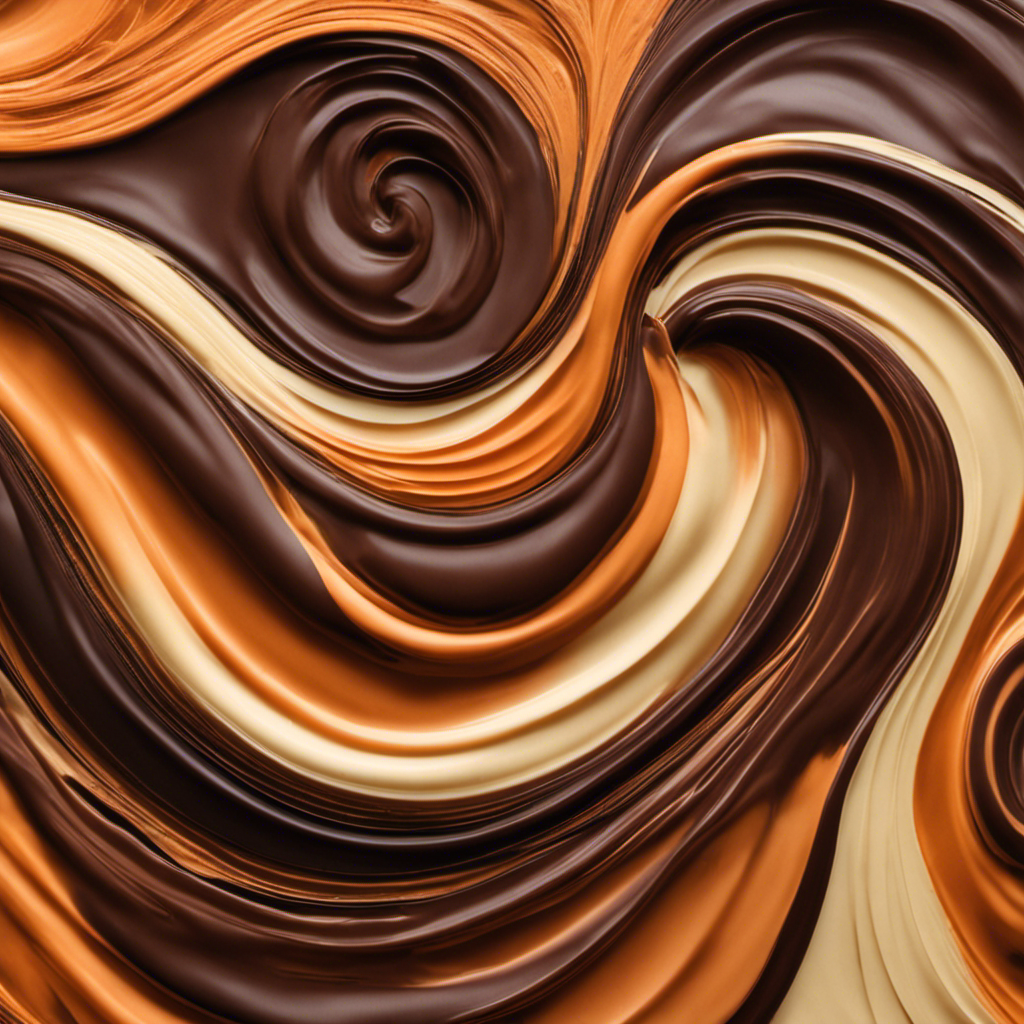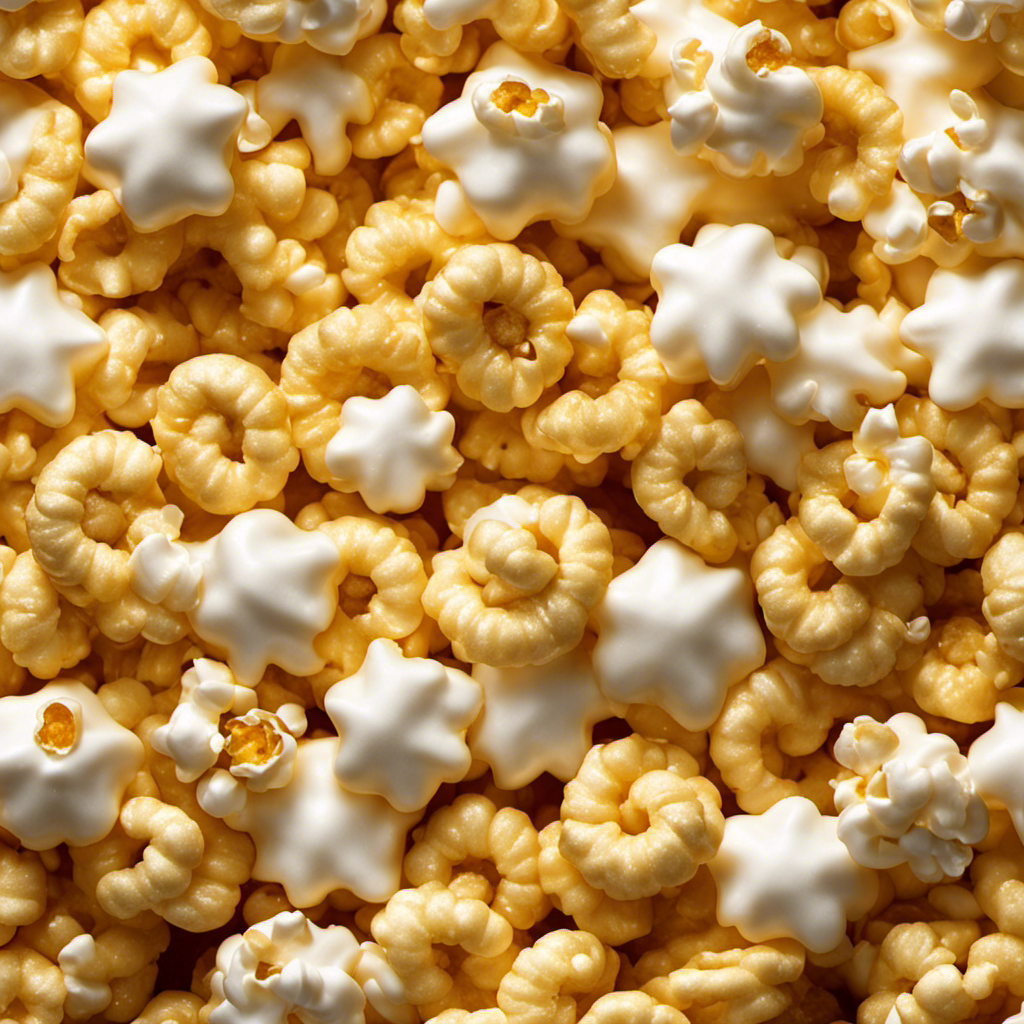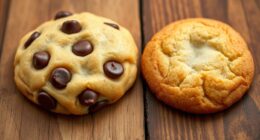I have always been very intrigued by state fairs. Did you know that there is a fair featuring a cow sculpture made of 600 pounds of butter? Yes, it’s true. This long-standing tradition has been captivating visitors for countless years.
In this article, I will take you on a journey to discover which state fair proudly showcases this incredible work of art. Get ready to be amazed by the history, techniques, controversies, and other unique attractions that make this fair truly one-of-a-kind.
Key Takeaways
- The tradition of the Butter Cow dates back to the early 1900s.
- The butter cow is a sculpture made entirely out of butter, representing the agricultural heritage and dairy industry of the region.
- Over 600 pounds of butter are used for the sculpture, which is carved by skilled sculptors using various techniques.
- Butter sculpture competitions featuring intricate sculptures are a popular attraction at state fairs, allowing visitors to witness the artists in action.
History of the Butter Cow Tradition
The tradition of the Butter Cow dates back to the early 1900s. The butter cow is a sculpture made entirely out of butter and has become a prominent feature at the state fair.
This tradition has deep cultural significance as it represents the agricultural heritage and dairy industry of the region. Each year, a skilled sculptor meticulously carves the butter into the shape of a cow, using over 600 pounds of butter.
The butter cow has become an iconic symbol of the state fair, attracting visitors from near and far. It is a testament to the craftsmanship and creativity of the artists, as well as a celebration of the state’s farming traditions.
The butter cow tradition continues to captivate and entertain fairgoers, preserving an important part of the state’s cultural heritage.
The Making of the 600-Pound Butter Cow
Craftsmen are currently making a 600-pound butter cow for the state fair. The process of sculpting a butter cow begins with a wooden frame that serves as the base for the sculpture. Using large blocks of butter, the craftsmen carefully mold and shape the cow, paying attention to every detail. They use various tools to create the cow’s body, head, and legs, ensuring that it looks realistic.
Once the sculpture is complete, it is placed in a temperature-controlled display case to prevent it from melting. Throughout the fair, the butter cow requires regular maintenance. This includes applying a layer of butter to maintain its smooth appearance and preventing any damage from occurring.
The butter cow is a fascinating tradition that showcases the incredible talent and dedication of these craftsmen.
State Fair Butter Sculpting Techniques
I’ve always been fascinated by the art of butter sculpting. Especially when it comes to the popular butter sculptures showcased at state fairs. These incredible creations are crafted using various techniques that allow artists to mold and shape butter into intricate designs.
State fair competitions bring out the best butter sculptors. They showcase their skills and compete for top honors.
Popular Butter Sculptures
You won’t believe the incredible butter sculptures that are featured at state fairs across the country. From intricate designs to larger-than-life creations, these butter sculptures have become popular attractions at state fairs.
Butter sculpture competitions have gained recognition in popular culture, showcasing the talent and creativity of artists who can transform a simple block of butter into a work of art. These sculptures often depict animals, famous landmarks, or even celebrities.
Some of the most well-known butter sculptures include a life-sized butter cow, weighing over 600 pounds, that is displayed at the Iowa State Fair. Other popular butter sculptures include butter sculptures of famous movie characters and historical figures.
These sculptures are a testament to the skill and imagination of butter artists and continue to captivate audiences at state fairs across the nation.
Techniques Used for Sculpting
Sculptors often use specialized tools and techniques to transform a simple block of butter into a detailed and lifelike sculpture. The artistic process behind butter sculpting involves the following techniques:
-
Carving: Sculptors use knives and other sharp tools to carefully remove layers of butter, creating the desired shape and form.
-
Modeling: By using their hands or small tools, sculptors can mold and shape the butter into intricate details and textures.
-
Texturing: Various tools, such as forks or toothpicks, can be used to create texture and patterns on the surface of the sculpture.
-
Finishing: To give the sculpture a smooth and polished appearance, sculptors often use heated tools to melt and blend the butter.
Overall, butter sculpting is a unique and challenging art form that requires precision and creativity. Through these techniques, sculptors are able to transform a simple block of butter into a stunning work of art.
State Fair Competitions
One of the most popular attractions at state fairs is the annual butter sculpture competition.
State fairs are known for their array of delicious state fair food and thrilling carnival games, but the butter sculpture competition is a unique highlight.
Artists from all over showcase their talent by sculpting intricate and lifelike sculptures using only butter.
These sculptures can range from animals to famous landmarks and can weigh up to 600 pounds.
The skill and dedication required to create these sculptures is truly impressive.
Visitors to the state fair can marvel at these buttery works of art and even witness the artists in action.
It’s a fascinating and deliciously creative competition that adds to the excitement of state fair season.
Famous Butter Sculptures at the State Fair
When it comes to butter sculptures at the State Fair, the artistic process behind them is truly fascinating. From the initial concept to the final creation, each sculpture goes through a meticulous process that showcases the skill and creativity of the sculptor.
What makes these sculptures even more unique is the medium itself – using butter as a material allows for intricate and detailed designs that are simply mesmerizing.
Furthermore, the cultural significance of these butter sculptures cannot be understated, as they often represent important figures, symbols, or events that hold significance within the community or region hosting the State Fair.
Artistic Process Behind
The artistic process behind creating the 600-pound butter cow is fascinating to observe. Here are the steps involved in bringing this impressive sculpture to life:
-
Planning: Artists carefully study reference images and plan the design before starting the sculpting process. They consider the size and shape of the cow, as well as any additional elements they want to incorporate.
-
Armature: A metal frame is created to provide support and stability to the sculpture. This frame acts as a skeleton for the butter to be molded around.
-
Sculpting: Using various artistic techniques, the artists sculpt the butter to shape the cow. They pay close attention to details such as the face, body structure, and fur texture to create a realistic and lifelike sculpture.
-
Finishing touches: After the main structure is complete, artists add final touches to enhance the sculpture’s appearance. This may include adding color or additional details to make the butter cow even more captivating.
The artistic techniques and skills showcased in these sculpting competitions are truly remarkable. Now, let’s explore some other unique butter sculptures that can be found at the state fair.
Unique Butter Sculptures
Let’s take a look at some of the remarkable and creative butter sculptures showcased at the state fair.
Butter sculpture competitions bring together talented artists who transform blocks of butter into stunning works of art. These artists use specialized tools to carve, shape, and mold the butter into intricate designs and sculptures.
From life-sized animals to famous landmarks, the butter sculptures never fail to impress. The level of skill and attention to detail displayed by these artists is truly remarkable. Each sculpture is a testament to their creativity and dedication.
These butter sculptures add a unique and artistic touch to the state fair, attracting visitors from far and wide.
Now, let’s explore the cultural significance of these butter sculptures and the traditions they represent.
Cultural Significance of
You’ll be amazed by the cultural significance behind these intricate butter sculptures. Butter sculpture techniques have been passed down through generations, making them an important part of many cultures around the world.
Here are four ways in which butter sculptures hold cultural significance:
-
Rituals and Celebrations: In many cultures, butter sculptures are created as offerings during religious ceremonies, festivals, or special occasions. They symbolize abundance, prosperity, and purity.
-
Cultural Identity: Butter sculptures often depict iconic figures, symbols, or scenes that represent a community’s history, mythology, or traditions. They serve as a visual representation of a group’s cultural identity and heritage.
-
Artistic Expression: Butter sculptures showcase the creativity and craftsmanship of skilled artists. They are a form of edible art, combining sculpting techniques with the unique medium of butter.
-
Community Engagement: Creating butter sculptures is often a communal activity, bringing people together to collaborate and celebrate their shared cultural heritage. It fosters a sense of belonging and pride within the community.
These butter sculptures not only showcase artistic talent but also hold deep cultural significance, making them an integral part of various traditions and celebrations.
Insider Tips for Viewing the Butter Cow
To get the best view of the butter cow, make sure you arrive early and avoid the crowds. The butter cow is a popular attraction at the state fair, drawing in thousands of visitors each year.
Insider tips for viewing the butter cow include finding the best time to visit when there are fewer people around. This usually means going on a weekday or during the early morning hours. It’s also helpful to have a viewing strategy in mind. Start from a distance and take in the overall sculpture, then move closer to appreciate the intricate details. Remember to be patient and respectful of others who are also trying to enjoy the artwork.
By following these tips and techniques, you can have a more enjoyable and memorable experience viewing the butter cow.
Now let’s delve into some of the controversies and criticisms surrounding this iconic fair exhibit.
Butter Cow Controversies and Criticisms
One of the controversies surrounding the butter cow exhibit is its high cost to create each year. The preservation and maintenance of the butter cow requires a significant amount of resources and expertise.
Here are the key points about the controversies and criticisms surrounding the butter cow at the state fair:
-
High cost: The creation of the butter cow involves purchasing large quantities of butter, which can be expensive.
-
Environmental concerns: Some critics argue that using such a large amount of butter for a temporary exhibit is wasteful and environmentally unfriendly.
-
Ethical concerns: There are debates about the ethics of using animal-based products, such as butter, for artistic purposes.
-
Public reactions: While the butter cow is a beloved tradition for many fairgoers, others question the necessity and value of such an exhibit.
Despite these controversies, the butter cow continues to be a popular attraction at the state fair, alongside other unique exhibits and events.
Other Unique Attractions at the State Fair
While exploring the state fairgrounds, don’t miss out on the chance to experience the unique attractions that make this event so memorable.
One of the highlights of any state fair is the delicious state fair food. From deep-fried Oreos to giant turkey legs, there is something for everyone’s taste buds. Indulging in these tasty treats is a must-do at any fair.
Another must-try experience is riding the carnival rides. From thrilling roller coasters to classic Ferris wheels, the state fair offers a variety of rides for all ages. Whether you’re a thrill-seeker or just looking for some fun, the carnival rides are sure to provide an exciting and unforgettable experience.
The Legacy of the Butter Cow at the State Fair
Don’t forget to check out the iconic butter sculpture that has become a beloved tradition at the state fair. The butter cow has a rich legacy and cultural significance that has captivated fair-goers for decades.
Here are four reasons why the butter cow holds such a special place in the hearts of attendees:
-
Historical importance: The butter cow tradition dates back to the early 20th century, making it a longstanding part of the fair’s history.
-
Artistic craftsmanship: Skilled sculptors meticulously shape the 600-pound butter cow, showcasing their talent and dedication to their craft.
-
Symbol of agriculture: The butter cow represents the agricultural roots of the state fair, highlighting the importance of farming and livestock in the region.
-
Community connection: The presence of the butter cow brings people together, creating a shared experience and fostering a sense of community among fair-goers.
The butter cow is not just a sculpture; it is a cherished symbol of tradition, creativity, and community at the state fair.
Frequently Asked Questions
What Is the History Behind the State Fair Where the 600-Pound Butter Cow Is Displayed?
The state fair that showcases a 600-pound butter cow has a rich history and is steeped in tradition. The event has become a beloved tradition, attracting visitors from all over to admire the impressive butter sculpture.
How Is the 600-Pound Butter Cow Actually Made?
Making a 600-pound butter cow involves sculpting layers of butter on a wire frame. The process requires precision and skill, as the artist carefully molds and shapes the butter to create a lifelike representation.
What Are the Specific Techniques Used for Sculpting Butter at the State Fair?
When it comes to sculpting butter at state fairs, various techniques are used. Artists compete in butter sculpture competitions, showcasing their skills in creating intricate and detailed sculptures out of this unique medium.
Can You Provide Information on Other Famous Butter Sculptures That Have Been Displayed at the State Fair?
I’ve seen some amazing butter sculptures at state fairs. From famous landmarks to intricate animals, these sculptures showcase the artistic process of butter sculpting in a truly unique way.
Are There Any Controversies or Criticisms Surrounding the Butter Cow Exhibit at the State Fair?
There have been controversies and criticisms surrounding the butter cow exhibit. Some argue that it promotes unhealthy eating and animal exploitation, while others believe it is a unique tradition worth preserving.
Conclusion
In conclusion, the Butter Cow at the state fair is not only a beloved tradition but also a remarkable feat of artistry.
This 600-pound masterpiece has been captivating fairgoers for decades, showcasing the talent and skill of the sculptors involved.
It’s worth noting that over 600 pounds of butter are used to create this iconic sculpture each year.
So, next time you visit the state fair, be sure to take a moment to marvel at this astonishing display of creativity and craftsmanship.
